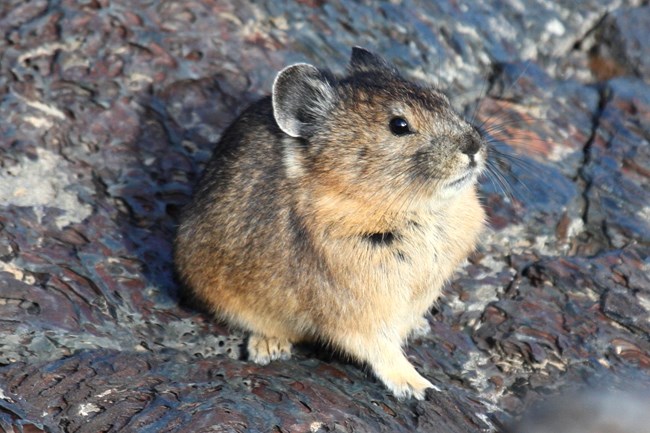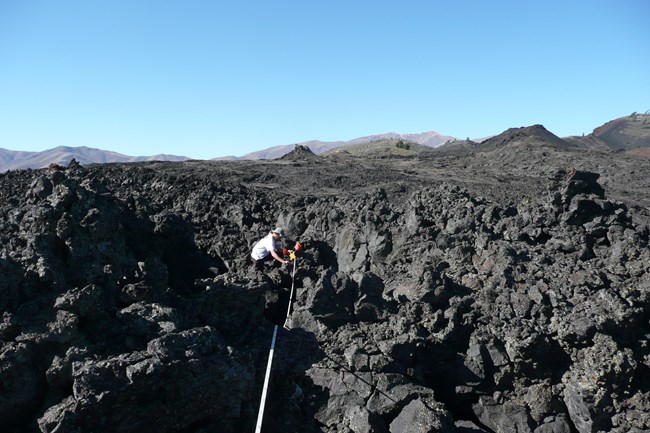Last updated: November 4, 2023
Article
Pikas at Craters of the Moon

Photo by Douglass Owen
Pikas remain one of the most enigmatic animals found in the park. Normally found in much colder environments, the pikas at Craters of the Moon scrape together a living among the dark lava flows.
Description and Behavior
Although similar in size and shape to a guinea pig, pikas are most closely related to rabbits and hares and therefore not rodents. Of the two species found in North America, the American pika (Ochotona princeps) is the only one found in the continental US. Adults tend to weigh about 4.8 ounces (170 g) with males slightly larger than females. Unlike rabbits and hares, pikas have short, rounded ears, front and back legs of equal length, and tails that are not visible.
Pikas are well-adapted to cold environments, having a dense coat of fur to keep them warm year-round.Because of this, pikas do not tolerate heat well and can die in temperatures above 75°F (24°C) after only a few hours. They do not hibernate and are active even when their dens are covered in snow.
During the growing season, pikas spend their time gathering edible plants, which they leave out to dry in "haypiles" before moving the dried plants into their dens for winter.
In addition to finding haypiles, another sign that indicates pikas are in the area are the high-pitched calls they make. Pikas are surprisingly vocal. Their calls sound similar to a squeaky toy and are used to communcate with each other and warn of predators.
-
Pika Calls
Pika calls at Stevens Pass, WA.
- Credit / Author:
- Jeff Rice, Western Soundscape Archive at the University of Utah J. Willard Marriott Library
- Date created:
- 08/04/2010
Habitat
Normally, pikas are found in cold environments like high-elevation talus slopes (slopes covered by rockfall) with little plant cover. Pikas make their dens under and around the rocks, away from the harsh elements.
At Craters of the Moon, pikas have been seen most often around the Lava Flow Campground, Spatter Cones, and Caves Area. These are all areas that have chunky, broken lava flows that have not yet been overgrown by plants and have many nooks and crannies to provide shelter. Even in areas where they have been confirmed to live, Craters of the Moon pikas tend to be shy and are uncommon see.

NPS Photo
Living on the Moon
The pikas found at Craters of the Moon are unusual for a variety of reasons. As far as biologists can tell, they are isolated to the lava flows in the park because they are unable to move outside the park to other suitable habitats. In both behavior and appearance, they are different from other populations of American pikas.
Summer air temperatures are often over 80°F (27°C) with the surface of the dark lava rocks sometimes exceeding 150°F (66°C); well above the pika's comfort zone. Pikas are diurnal, which means they are active during the day, just like humans. Because summer temperatures get so high at Craters of the Moon, pikas at the park have adapted by being much more active in the morning and evening when the temperatures are cooler. On the hottest days, Craters pikas may not be active above ground at all. Even with this smaller window, the park's pikas are able to gather as much food for the winter as their higher elevation counterparts.
Compared to other populations, the pikas at Craters of the Moon also tend to be darker in color, most likely to blend in better with the black rocks.
Ongoing studies are trying to determine whether or not the Craters of the Moon pikas are genetically unique from other populations.
Conservation
The National Park Service monitors pika populations within the park to determine their abundance and distribution. This is done using a noninvasive technique of observing and collecting pika scat to determine where the pikas live. Along with providing information on the location of pika populations, pika scat may also provide valuable information in terms of genetics, diet, and reproduction.
Sources
Beever EA. (2002) "Persistence of pikas in two low-elevation national monuments in the western United States." Park Science. Vol 21: No. 2, 23–29
Camp, Meghan J.; Shipley, Lisa A.; Varner, Johanna; and Waterhouse, Brooklyn D. (2020) "Activity patterns and foraging behavior of American pikas (Ochotona princeps) differ between Craters of the Moon and alpine talus in Idaho," Western North American Naturalist: Vol. 80: No. 1, Article 6
Smith, Andrew T. (1974) "The Distribution and Dispersal of Pikas: Influences of Behavior and Climate," Ecology. Vol. 55: No. 6, Article 17
